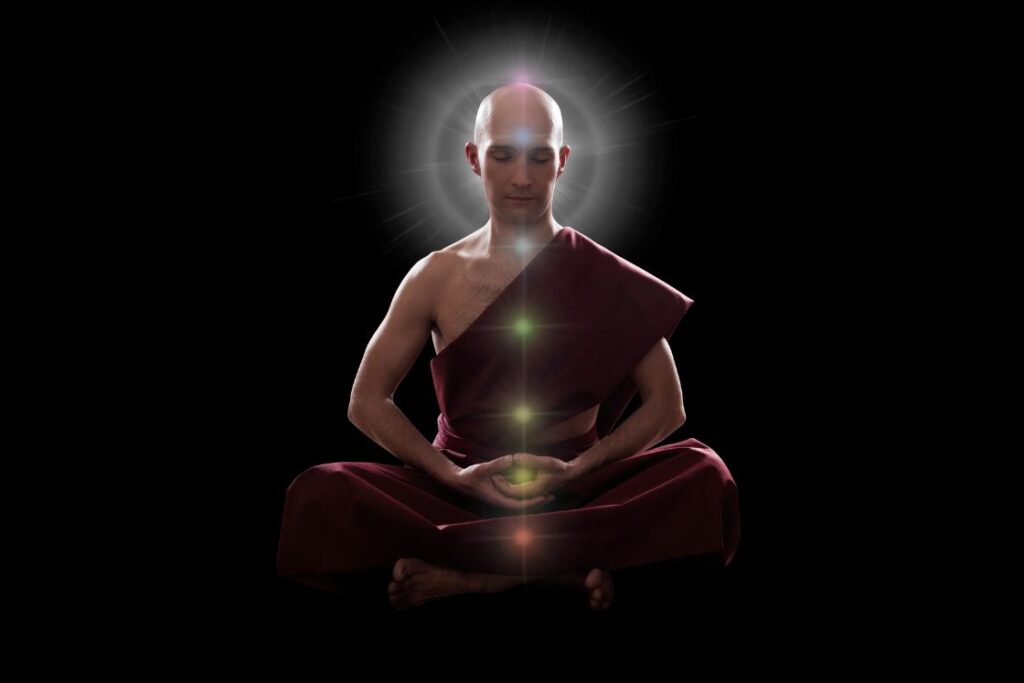
There is no approaching Tantra Yoga without addressing the meaning of Tantra. Tantra is one of the most controversial areas in Indian spiritual philosophy. It is often undervalued by the other prominent forms of Yoga. However, Tantra is a very comprehensive topic that expands far beyond the westernized idea of blending spirituality with euphoric sexual experiences.
In practice, the word tantra had a rather straightforward application, referring to doctrines or theories. Although it generally didn’t refer to any random book or doctrine, but only the ones in scriptural format with spiritual and divine relevance.
Tracing down the proper historical root of tantra is very difficult since most of the texts were destroyed, especially during the era when the tantric practices picked up a negative annotation and were associated with sacrilege. It is widely believed that the tantric practices gained prominence during the 6th Century, when the tantric scriptures started emerging throughout the Indian Subcontinent. Back then the Tantric scriptures were called, Agama, meaning, “what has come down to us.”
The Sanskrit meaning of the word Tantra is “Weaving,” or “ïnteronnection.” The tantras were scriptural texts that compiled and inter-connected a complete system of all the existing spiritual know-hows. Thus the tantric practices weaved together all the knowledge, information, theories, philosophies, technicalities, beliefs, rituals, practices, wisdom, research and experiments that associate with spiritual and divine realizations. This completeness of the tantric practice made it being considered so powerful across the yogic tradition, and sometimes even feared.
Thus to sum it up, Tantras are the scriptural texts that mention the tantric practices, where the tantric practices were a complete and interconnecting system of all the spiritual know-hows. One might say that the art of Tantra is an extreme discipline, that teaches you to use your mind and body like an instrument, to their maximum potential.
Tantra philosophies
An important part of the Indian philosophies are the philosophies of Hinduism. The Shad-darshana, or the six systems of Indian Philosophy, are, sankhya, Yoga, Nyaya, Vaisheshikha, Mimamsa and Vedanta. These philosophies consider the Vedas as the ultimate authority.
However, the vedic period only starts from 500 BC. The Indian Subcontinent on the other, has been populated since as early as 9000 BC. And the first signs of civilization emerged in 3500 BC. Naturally the philosophies of the pre-vedic period are also Indian philosophies. Thus considering Vedas to be the supreme authority is a bit incomplete. This is why Nastika Indian philosophies like Buddhism, Jainism, Carvaka, Ajivaka and such, reject the Supreme authority of the Vedas.
This is where Tantra gets interesting. Tantra neither rejects the Vedas as the supreme authority, nor accepts. Traditionally the tantrics never much cared for philosophical politics. Rather they sincerely pursued the apparently elusive mysteries of life. This pursuit led them to experience the different realities of interactions between humans and all other creations.
Tantrics were radical and free thinkers. The only thing that mattered to them was the truth, irrespective of its unpleasantness. And they embraced the truth and incorporated it in their practices. The major contradiction of Tantra with many religious philosophies, is that it prioritizes the truth over moral and ethics.
The emphasis of tantra lies in the practice of the elusive truths and realities, and not philosophies. In fact the scriptural texts of tantra mention more of the practices, and the philosophies found were just annexures to practices.
The revered spiritual yoga practices focus on moksha or liberation from the world. But the Tantra practices aim to achieve liberation in the world. The pri-veda yogis focus on aligning their consciousness with the common consciousness of all creations.
The pri-veda yoga practices advocate minimising bodily experiences, and increasing meditative exploration into the realms of consciousness and awareness. Which will eventually establish unity with the divinity.
Tantra is a whole different ball game, different to the point that they even contradict Bhagavad Gita. Tantric Tradition states that, “life is not suffering and life is not Maya.” Tantric practices highly value the worldly and bodily experiences. In fact the core essence of Tantra is exploring spiritual realities through subtle interactions between worldly experiences.
While a pri-veda yogi says that our bodily experiences limit our minds from liberation. A tantric yogi says just the opposite. He delves so deep into the bodily experiences, that he gains absolute mastery over the elusive subtleties. Using this mastery he establishes a worldly system capable of generating spiritual relevance.
What is Tantra Yoga?

The word Tantra is taken from two Sanskrit root words, Tanoti meaning expansion, and rayati meaning liberation. Thus the word Tantra means liberation through expansion ( of worldly experiences.) And Tantra Yoga becomes the discipline to unite with the art of liberation through expansion.
Note that the word expansion encompasses expansion of experiences, beliefs, practices and knowledge. This is why a Tantric is always keen on learning more, and is always accepting of new possibilities as long as it is logical and based in reality.
In practice Tantra yoga includes techniques of asana, advanced Pranayama, chanting mantras, Tantra mudras and mantras, and a diverse range of esoteric and occultist rituals. The asanas involved in Tantric practices use mostly hatha yoga poses, especially, inversions, side bends, forward folds, twists and backbends. Tantra yoga, like other spiritual forms, focus sufficiently on techniques of kundalini flow and chakra cleansing.
How tantra Yoga changes you as a person?
If you’re expecting to achieve supernatural abilities with Tantra, then you will most likely be disappointed. But there is one thing for sure with Tantra, that you will develop a surprisingly high tolerance for truth. Irrespective of the harshness of it. You will also be exposed to all the realities of natural existence, both its light and dark sides. And thus you will develop a fearless attitude in life.
Tantra practices also teach a great level of mastery over the body, and hence, it will improve your physical conditioning as well. Tantra will bring the following changes to your life:
- Fearless personality
- High acceptance of truth
- A sense deeply rooted in reality
- Highly matured wisdom developed from diverse experiences
- An accepting mentality to different theories and philosophies
- Mental strength to overcome hardships
- A mind nurtured with holistic knowledge
- Increased physical strength and endurance
- Improved metabolism
- Stable nerves and calm mind
- Boosted immunity
- Greatly enhanced cognition
Types of Tantra Yoga
Tantra yoga is a broad subject with many subparts. Different practices, difficulty levels and subcategory belief systems led to different types of Tantra yoga.
These different types of tantra yoga can be broadly categorized into the following categories:
1. Kaula
The Kaula school of tantric practices focuses mostly on practices for satisfying physical or worldly needs. These practices have a strong footing in the spiritual realm, but they lack a philosophical context. These practices are not directed towards a greater purpose, but just fulfillment of desires and wants, utilizing the divinity.
The Kaula is further divided into two prominent categories, the vama marga and dakshina marga. The vama marga involve the more occultist practices and is often associated with negative influences. The dakshina marga is often termed the white tantra. The rituals practiced are within social norms and focus on liberation of the soul.
2. Mishra
The word Mishra means mix, and thus the Mishra school of Tantra Yoga advocates a practice that blends both body based practices and rituals, and meditative practices and rituals. The mishra school of Tantra gives the practitioners a balance of outward benefits and internal harmony.
3. Samaya
The word Samaya means to be “one with her,” and it is considered the highest and purest form of Tantric practice. Samaya school focuses entirely on internal aspects like consciousness and awareness. The pursuit of Samaya Tantra will lead the practitioner to oneness with the “Divine mother.”
This school of tantra considers the “Divine mother” as the source of all creation, and that everything that exists is her manifestation. Like the waves in an ocean, all creations rise from her and subside in her. Thus the worldly experiences and rituals in Samaya Tantra are a means to appreciate the beauty of the divine mother’s creation. And the meditative techniques are a means to liberate the mind and unite with the universal consciousness.
Fundamentals of Tantra Yoga Practices
When one chooses to practice tantra yoga the first thing he/she will notice is that it’s not just about the physical form of it, but the approach. In most yoga classes there will be either of two goals, physical well-being or liberation of mind. In Tantra however, seeking the truth is the ultimate goal; asanas, pranayama, mantras, mudras and bandhas are all just preparatory practices leading to the ultimate goal.
- Find a legit teacher – To help you avoid pleasure pitfalls.
- Cherish the subtleties of creation – Like the scent and color of a flower, the silence of night and the playfulness of a child. Appreciate these subtleties to appreciate the beauty in Divine mother’s creation.
- Get comfortable with silence – This will help you focus
- Develop inner peace – Sit still and breathe. Let your mind be flooded with the naturally flowing thoughts. Embrace the thoughts but do be affected by them, emotionally or intellectually. Over a time the flow of thoughts will become unnoticeable.
- Chakra Cleansing meditation – This will trigger kundalini flow in your body. Blocked chakras will hinder self-realization.
- Chant Tantric Mantras – The tantric mantras help generate sound frequencies that establish favorable conditions for your body and mind
- Practice pranayama – Pranayama breathing improves the flow of life force within you and enhances the physiological condition of your body organs
- Practice Hand gesture/Mudras – Hand mudras and gestures help you control your energy pathways (Nadis) to generate specific physical and mental benefits.
- Practice Hatha yoga Asanas – Sarvangasana, Naukasana, Surya Namaskara, forward bend, chakrasana, Purna Matsyendrasana and Parivrtta Janu Sirasana, are a few good choices
To conclude, tantra yoga is an extreme discipline which even the most advanced level yogis stay away from. Now it’s not necessarily because it’s harmful, but it’s a different path entirely, and not many find the calling for it. So before one thinks of pursuing Tantra one must be absolutely sure of it. However, academic explorations into the subject can be absolutely delightful, revealing and intriguing.




